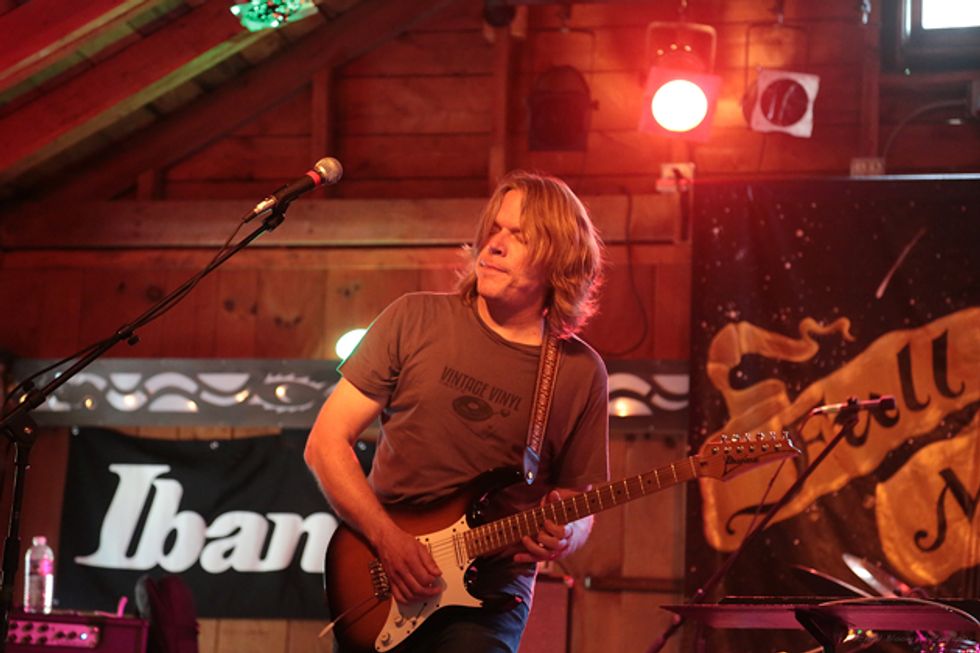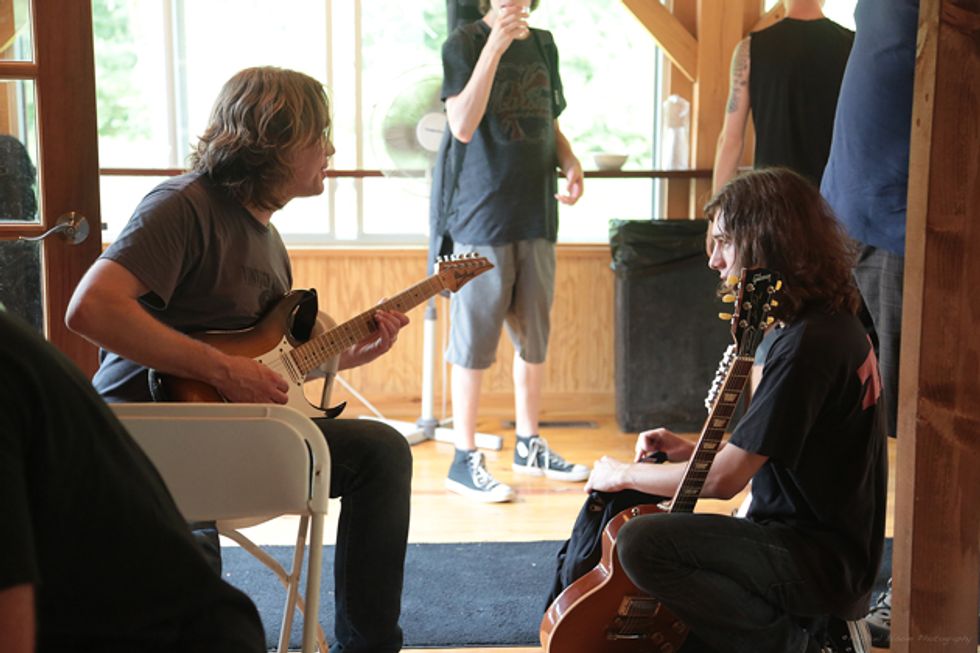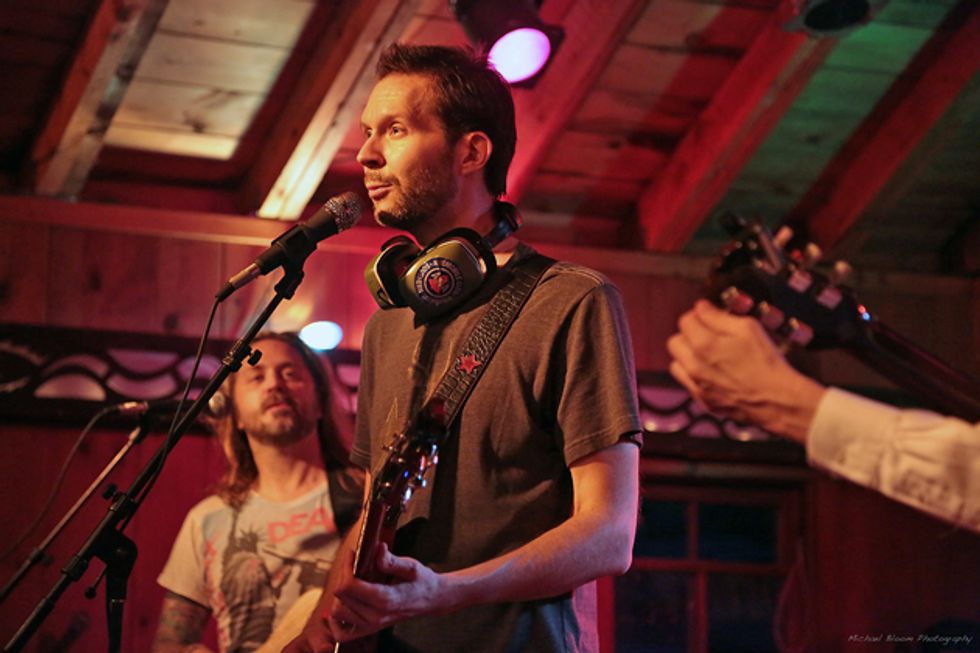While attending the Paul Gilbert Great Escape 2013, Premier Guitar was able to snag some quality face time with two major names in the guitar industry: Paul Gilbert and Andy Timmons. Longtime shredder Gilbert is renowned worldwide for his playing abilities in Mr. Big and beyond, but also for his aforementioned camp, which allows budding players to learn from the best of the best.
Among the teachers this year was Andy Timmons, a guitarist whose musical breadth lets him open arena shows with Danger Danger and arrange entire Beatles albums as 6-string instrumentals (a real cake walk, you know). Both Gilbert and Timmons offered insights into their personal learning processes and described what it’s like to be a teacher of the trade.
What are the most common questions or concerns that you hear from students?
Timmons: It seems like people are looking for the magic bullet or the shortcut, and the unfortunate answer is there never is any. In general, it’s always the same stuff we all need to work on—improving your ear and working on time and feel. Vocabulary and technique come the more you play.
Gilbert: At the camp, these are students who have come to see, I’m assuming, primarily me, so it’s a unique bunch of people because chances are they’ve seen my early instructional videos where I’m doing all the shred stuff. A lot of it is people wanting to know, “How do I use this three-notes-per-string scale to play really fast?”
But your musical tastes have changed drastically from the purely shredding aspect you focused on when you first hit the scene, right Paul?
Gilbert: In my own personal journey, [shredding] was certainly part of it. But my ears and my hands have opened up to so many other styles that I can’t help but try to pull them into that direction a little bit.
How do you address these topics to a large audience with people of differing levels?
Timmons: I just try to touch on things that are universal. When I get into more advanced things, maybe it might wash over younger, less experienced players. But it might be something that they get to later in life. “Oh yeah, that’s what he was talking about. I get it now.” That was the thing in my own education over the years. I was a self-taught player from 5 to 16. When I went to the University of Miami for two years, the great thing about the curriculum was it gave me a lifetime of things to work on. It wasn’t like, “Here’s a book of licks, now learn this.” It was more like, “Here are pieces to the puzzle, now it’s up to you how you put it together.”
In the jams, it’s obvious that the majority of students here can play at a pretty high technical level. However, there is a noticeable difference in how they sound when compared to either of you two or another established professional. What steps do you take to try to lead the students into sounding like a polished pro?
Timmons: For these players, it’s probably about listening. It comes down to awareness and fitting into every musical situation. You have to be musical with your knowledge. There’s a generation of guitarists that grew up with a wealth of information. There’s the internet, tab, and YouTube. There’s so much information—it’s all out there, and you have to kind of edit.
Gilbert: It depends on the framework. Every guitar player has a stylistic direction they’ve gone in. Somebody like Yngwie is a master of his style. If you want to play Phrygian Dominant over an E chord, nobody can touch that guy. But if he had to play “Autumn Leaves,” I would guess, and I don’t want to say anything bad about Yngwie, but it probably wouldn’t go that well. That’s the same thing with me. If I had to play “Autumn Leaves,” it would be a disaster. I haven’t explored that area enough. When I was a kid I had a teacher who was good at showing me scales and chords. He was very methodical and I learned a lot from him. But then my uncle, who is a fantastic guitar player, would pick up a guitar and play something with force [demonstrates]—great vibrato, dynamics, and all of those elements that can’t be written on tablature. And that’s the thing that I find. Some students play like tablature.
How do you convey musicality to a student who might be more focused on the technical aspects of guitar playing?
Timmons: When I was in school, I was learning Charlie Parker solos and exploring theory, yet I was also playing in a Top 40 band and could instantly apply what I learned. Not scales though. Learning scales is great for learning the guitar and learning about the construction of music, but then it’s really important to kind of forget it. You hear guys who just play a lot of scales and it can be interesting but to a certain degree, it’s not melodic. They’re thinking of patterns and notes. To me it’s more about, “What can I do to make this an interesting line?”
Gilbert: As a teacher I’ve got to be able to put those elements into very clear, obvious, and understandable terms. I’ve always been frustrated when people say, “Oh, it’s just feel.” They’re right, but to me, that’s a really unsatisfying term. It doesn’t tell you anything. If you tell a student, “You need to work on your feel.” That’s completely, utterly unhelpful. You can’t just spill out the information you know, you actually have to communicate to human beings and figure out where they’re at and what they’re ready for. It’s not just like giving them a dictionary and saying, “Here, memorize it.” You’ve got to break it down to the elements. Like, “What goes into that?” Through my online school and through teaching at MI [Hollywood’s Musicians Institute], I’ll hear somebody and realize that there’s something missing. And initially I can’t figure out what it is. But from having a lot of teaching experience, now I can spot it. A lot of it is dynamics, which is huge.
Can you give some examples?
Gilbert: It could be something as simple as playing two notes and playing the first one loud and the second one soft—you wouldn’t believe it, but some people have never worked on that [demonstrates]. Or playing the first one quiet and the second one loud [demonstrates]. A lot of people will play scales where everything is the same volume but they never work on dynamics [demonstrates]. That’s music, and that’s just one element. I tell the students “You can play fast but at the end of it, eventually there has to be a last note and that last note has to be great.” That’s the thing that people are going to remember. That’s where you have to reference blues vibrato or be able to control the other strings and things like that. I tend to look at these elements because a lot of the people who have been influenced by me tend to focus more on scales—a student I heard yesterday was way faster than I am.
Paul, you’ve talked a lot about playing over changes this week. You also chose songs with lots of hard-to-navigate changes in the concerts. What is spurring this interest?
Gilbert: I can hear so much deeper into music now than when I was a kid. Back then all I could hear was the vocal note. I couldn’t even hear the guitar part. It took me years to discover that a chord was the accompaniment and to be able to separate it out. All I could hear was power chords—the root and the fifth. I couldn’t hear the third and the seventh. Then I went to school and was like, “Oh, so that’s what a dominant chord is?” And I began to hear intervals. Now my ability to hear intervals is so much better and because I can hear them, it makes me want to hear them. For example, a friend played me a song by the band Tool. Rhythmically, it was very, very cool, but harmonically, it was one chord for the whole song. And I don’t want to make Tool fans angry, but I just got bored so quickly. For my ears, I need something to happen harmonically.
I’ll bet some of the kids here are probably diehard Racer X fans that might not immediately “get ” why you’re playing songs by Stevie Wonder or The Doors in your nightly concerts.
Gilbert: It’s less about me wanting to open their ears than it is about me wanting to open my own ears. Hopefully they’re not horribly disappointed. I was there, too. I remember when my favorite chord progression was the heavy metal progression [plays A5–F5–G5] and there’s still a great beauty to that. That’s still a great progression. If I were still into that I would do it. It’s definitely a little bit of a selfish decision, playing what I want. I just love that stuff and I think the main thing that I want to communicate is the love of music. That’s why I have a variety of musicians up there—Mimi Fox playing traditional jazz, Tony Spinner playing slide and greasy blues, Scotty [Johnson] doing fusion stuff, and Andy doing his Beatles melodies, and Adam [Fulara] playing some ridiculous things with the doubleneck. But the thing that ties it together is that everybody is unbelievably focused and passionate, and just loves what they’re doing. The one mistake I made at this camp is that I offered myself up for private lessons. I have a great time doing that but I’m missing out on being a student myself!


















![Rig Rundown: Russian Circles’ Mike Sullivan [2025]](https://www.premierguitar.com/media-library/youtube.jpg?id=62303631&width=1245&height=700&quality=70&coordinates=0%2C0%2C0%2C0)
















![Rig Rundown: AFI [2025]](https://www.premierguitar.com/media-library/youtube.jpg?id=62064741&width=1245&height=700&quality=70&coordinates=0%2C0%2C0%2C0)




















 Zach loves his Sovtek Mig 60 head, which he plays through a cab he built himself at a pipe-organ shop in Denver. Every glue joint is lined with thin leather for maximum air tightness, and it’s stocked with Celestion G12M Greenback speakers.
Zach loves his Sovtek Mig 60 head, which he plays through a cab he built himself at a pipe-organ shop in Denver. Every glue joint is lined with thin leather for maximum air tightness, and it’s stocked with Celestion G12M Greenback speakers.






